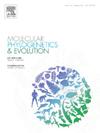Phylogenomics offers new insights into the classification of Phytoseiidae (Acari: Mesostigmata)
IF 3.6
1区 生物学
Q2 BIOCHEMISTRY & MOLECULAR BIOLOGY
引用次数: 0
Abstract
Phytoseiid mites are significant natural predators of harmful mites and constitute one of the largest groups within Gamasina (Acari: Mesostigmata). The currently accepted classification divides the Phytoseiidae family into three subfamilies, primarily based on the pattern of their dorsal setae. However, the phylogenetic relationships among these subfamilies remain unresolved. To address this issue, we sampled forty representative species from the three subfamilies. Using a specific Arachnida reference dataset (orthodb10, n = 2,934), we mined thousands of universal single-copy orthologs from whole-genome sequencing data. We then constructed four amino-acid matrices, taking into account evolutionary rates and the degree of violation of the molecular clock (DVMC). Phylogenetic trees were reconstructed using both concatenated and multispecies coalescent (MSC) analyses. Based on maximum likelihood and Bayesian inference, the majority of the phylogenetic trees supported the hypothesis (P2) of Phytoseiinae + (Typhlodrominae + (Galendromus + Amblyseiinae)). However, when using slowly evolving and non-clock-like genes, the MSC trees supported an alternative hypothesis (P1) of Typhlodrominae + (Phytoseiinae + (Galendromus + Amblyseiinae)). Additional analyses, including model fitness, topology tests, and morphological comparisons, favored the hypothesis P2. Our findings indicate that Typhlodrominae is not monophyletic, and Galendromus and Amblyseiinae are sister groups. Based on these results, we recommend that Galendromus be separated from Typhlodrominae and elevated to a fourth subfamily.

系统基因组学为蜱螨科的分类提供了新的见解(蜱螨亚纲:中鞭毛目)
植物螨是有害螨的重要天敌,是革螨目(蜱螨亚纲:中鞭毛目)中最大的类群之一。目前公认的分类将植物科分为三个亚科,主要基于它们的背刚毛模式。然而,这些亚科之间的系统发育关系仍未得到解决。为了解决这个问题,我们从三个亚科中取样了40个有代表性的物种。使用特定的蛛形纲参考数据集(orthodb10, n = 2934),我们从全基因组测序数据中挖掘了数千个通用的单拷贝同源物。然后,我们构建了四个氨基酸基质,考虑到进化速率和分子时钟(DVMC)的破坏程度。利用串联和多物种聚结(MSC)分析重建了系统发育树。基于极大似然和贝叶斯推理,大多数系统发育树支持植物seiinae + (Typhlodrominae + (Galendromus + Amblyseiinae))的假设(P2)。然而,当使用缓慢进化和非时钟样基因时,MSC树支持另一种假设(P1),即Typhlodrominae + (phytoseiae + (Galendromus + amblyseiae))。其他分析,包括模型适应度、拓扑测试和形态比较,支持假设P2。我们的研究结果表明,Typhlodrominae不是单系的,Galendromus和Amblyseiinae是姐妹类群。基于这些结果,我们建议将Galendromus从Typhlodrominae中分离出来,并将其提升到第四个亚科。
本文章由计算机程序翻译,如有差异,请以英文原文为准。
求助全文
约1分钟内获得全文
求助全文
来源期刊
CiteScore
7.50
自引率
7.30%
发文量
249
审稿时长
7.5 months
期刊介绍:
Molecular Phylogenetics and Evolution is dedicated to bringing Darwin''s dream within grasp - to "have fairly true genealogical trees of each great kingdom of Nature." The journal provides a forum for molecular studies that advance our understanding of phylogeny and evolution, further the development of phylogenetically more accurate taxonomic classifications, and ultimately bring a unified classification for all the ramifying lines of life. Phylogeographic studies will be considered for publication if they offer EXCEPTIONAL theoretical or empirical advances.

 求助内容:
求助内容: 应助结果提醒方式:
应助结果提醒方式:


